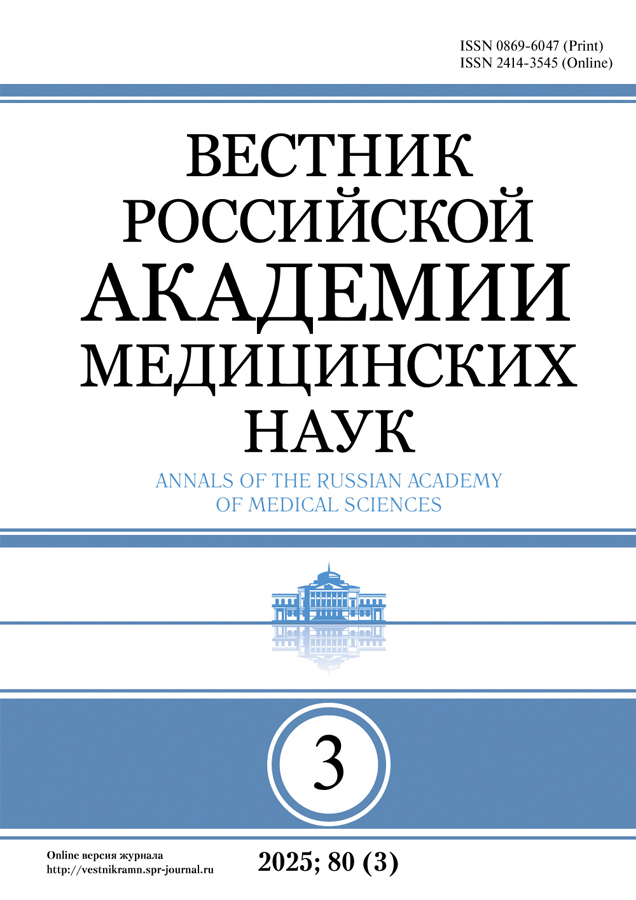СОВРЕМЕННАЯ НЕЙРОЭНДОКРИНОЛОГИЯ
- Авторы: Дедов И.И.1, Мельниченко Г.А.1, Липатенкова А.К.1
-
Учреждения:
- Эндокринологический научный центр, Москва
- Выпуск: Том 67, № 8 (2012)
- Страницы: 7-13
- Раздел: МАТЕРИАЛЫ СЕССИИ РАМН
- Дата публикации: 11.08.2012
- URL: https://vestnikramn.spr-journal.ru/jour/article/view/271
- DOI: https://doi.org/10.15690/vramn.v67i8.343
- ID: 271
Цитировать
Полный текст
Аннотация
Об авторах
И. И. Дедов
Эндокринологический научный центр, Москва
Автор, ответственный за переписку.
Email: teofrast2000@mail.ru
академик РАН и РАМН, Президент РАМН, директор ФГБУ «Эндокринологический научный центр» Минздравсоцразвития России Адрес: 117036, Москва, ул. Дмитрия Ульянова, д. 11 Тел.: (499) 124-43-00 Россия
Г. А. Мельниченко
Эндокринологический научный центр, Москва
Email: teofrast2000@mail.ru
академик РАМН, директор института клинической эндокринологии ФГБУ ЭНЦ Минздравсоцразвития России, Москва Адрес: 117036, Москва, ул. Дмитрия Ульянова, д. 11 Тел.: (495) 500-00-96 Россия
А. К. Липатенкова
Эндокринологический научный центр, Москва
Email: teofrast2000@mail.ru
Россия
Список литературы
- Scharrer E. Die Lichtempfindilichkeit blinder Elritzen (Untersuchungen uber das Zwischenhirn der Frische. Z.Vergleich.Physiol. 1928; 7: 1—38.
- Scharrer E. Scientia. 1952; 46: 177—183.
- Polenov A.L. Gipotalamicheskaya neirosekretsiya. L., 1968.
- Hоkfelt Т., Johansson O., Efendic S. et al. Are there somatostatin-contatning nerves in the rat gut? Immunohistochemical evidence for a new type of peripheral nerves. Experientia.1975.
- Hоkfelt Т., Johansson O., Ljungdahl et al. Peptidergic neurones. Nature.1980; 284 (5756): 515—521.
- Inagaki S., Kitos S. Peptides in the peripheral nervous system. Progr Brain Res. 1986; 66: 269—316.
- Akmaev I.G. Strukturnye osnovy mekhanizmov gipotalamicheskoi regulyatsii endokrinnykh funktsii. M.: Nauka. 1979.
- Pelletier G. Hypothalamus and endocrine functions. Ed. F. Labrie et al. N.Y: Plenum Press. 1976. P. 433— 450.
- Kettail V.M., Arki A.R. Patofiziologiya endokrinnoi sistemy M.: Binom. 2009. S. 32—40.
- Mehlmed S., Polonsky K.S., Larsen P.R., Kronenberg H.M. Eds. Williams Textbook of Endocrinology, 12 ed. 2011. Р. 8.
- Babichev V.N. Retseptory steroidnykh gormonov i ikh rol' v razvitii gipofizarnykh opukholei. Problemy endokrinologii. 2004; 50 (5): 49—54.
- Maisello D. Shomo melmed pituitary tumorogenesis. Arquivos Brasileiros de Endocrinologia and Metabolisma. 2005; 49 (5): 12—14.
- Pivonello R. Dopamin D2 receptor expression in the corticotroph cells of the human normal pituitary gland. J Hormones. 2006; 5 (1): 45.
- Chee G.M., Mathias D.B., James R.A., KendallTaylor P. Transsphenoidal pituitary surgery in Cushing’s disease: can we predict outcome? Clin Endocrinol (Oxf). 2001; 54: 617—626.
- Kolesnikova G.S., Goncharov N.P., Zhimirikina M.L. i dr. Funktsional'noe sostoyanie gipofizarnoi sistemy v otdalennye sroki posle protonnogo oblucheniya u patsientov s bolezn'yu Itsenko—Kushinga. Sovremennye tekhnologii v endokrinologii. M., 2009. S. 107.
- Рatil C.G., Veeravagu A., Prevedello D.M. et al. Outcomes after repeat transsphenoidal surgery for recurrent Cushing’s disease. Neurosurgery. 2008; 63 (2): 266—270. [Discussion 270—271].
- Liubinas S.V., Porto L.D., Kaye A.H. Management of recurrent Cushing’s disease. J Clin Neurosci. 2011; 18 (1): 7—12. [Epub 2010 Sep 18].
- Colao M.D. et al. Pasireotide B2305 Study Group. N Engl J Med. 2012; 366: 914—924.
- Chikulaeva O.A. Molekulyarno-geneticheskie, gormonal'nye i immunologicheskie osobennosti vrozhdennoi somatotropnoi nedostatochnosti u detei. M., 2005. S. 40.
- Dedov I.I., Peterkova V.A., Nagaeva E.V. Gormon rosta v sovremennoi klinicheskoi praktike. Lechashchii vrach. 2007; 2: 22—27.
- Dedov I.I., Vaks V.V. Molekulyarno-geneticheskie aspekty patogeneza opukholei gipofiza. Aktual'nye problemy neiroendokrinologii: Materialy konferentsii. M., 2003. S. 41—45.
- Barlier A., Gerard С. Oncogene gsp and Gsα overexpression in pituitary cell biology. Endocrine. 2007; 14. [Abstracts].
- Zhou C., Wawrowsky K., Bannykh S. et al. E2F1 induces pituitary tumor transforming gene (PTTG1) expression in human pituitary tumors. Mol Endocrinol. 2009; 23 (12): 2000—2012. [Epub 2009 Oct 16].
- Nabarro J.D. Acromegaly. Clin Endocrinol (Oxf). 1987; 26 (4): 481—512.
- Cook D.M., Ezzat S., Katznelson L. et al. Vance and aACE acromegaly guidelines task force AACE medical guidelines for clinical practice for the diagnosis and treatment of acromegaly. Endocrinol Pract. 2004; 10 (3): 213—225.
- Freda P.U., Katznelson L., Aart J. et al. Longacting somatostatin analog therapy of acromegaly: a meta-analysis. J Clin Endocr Metab. 2005; 90 (8): 4465—4473.
- Ferone D., Gatto F., Arvigo M. et al. The clinicalmolecular interface of somatostatin, dopamine and their receptors in pituitary pathophysiology. J Mol Endocrinol. 2009; 42 (5): 361—370. [Epub 2009 Jan 13].
- Swearingen В., Barker F.G., Katznelson L. et al. Longterm mortality after transsphenoidal surgery and adjunctive therapy for acromegaly. J Clin EndocrMetab. 1998; 83 (10): 3419—3426.
- Erfurth E.M., Bulow B., Mikoczy Z. et al. Is there an increase in second brain tumours after surgery and irradiation for a pituitary tumour? Clin Endocrinol (Oxf). 2001; 55: 613–616.
- Gerasimov G.A. Differentsial'naya diagnostika i lechenie adenom gipofiza i sindroma giperprolaktinemii. Avtoref. dis. …dokt. med. nauk. M., 2001. S. 40.
- Dedov I.I., Mel'nichenko G.A., Romantsova T.I. Sindrom giperprolaktinemii. M.: Triada. 2004. S. 304.
- Colao A., Di Sarno A., Landi M.L. et al. Macroprolactinoma shrinkage during cabergoline treatment is greater in naive patients than in patients pretreated with other dopamine agonists: a prospective
Дополнительные файлы








